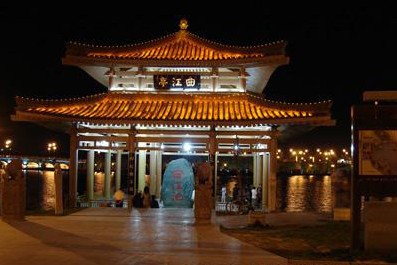
The third prize of the 2009 Zhongzhao Award, Xi'an Qujiangchi Ruins Park
Background introduction
Qujiangchi is a famous historical relic of Xi'an. It has a large scale in the Qin Dynasty. Qujiang is an imperial garden. It is a famous scenic spot in Chang'an City. In order to reproduce the moving scenery of Qujiangchi, Xi'an Municipal Government has recently visited Qujiangchi in Xi'an. The site was extensively restored. The completed Qujiangchi Relics Park is an open urban eco-cultural park that integrates historical and cultural protection, ecological gardens, landscapes, leisure tourism, folk heritage and art display. It is designed by the well-known architect of the famous architectural design, Zhang Jinqiu, with a total planning area of ​​1,500 mu. It restores 700 mu of the Hanjiang Qujiangchi water system and reproduces the landscape of humanity in the Qujiang area, where the Qinglin is repeated and the green water is pervasive. After the completion of the Qujiangchi Ruins Park and the surrounding Qujiang Hanyao Ruins Park, Qin Ershiling Site Park, Tangcheng Wall Ruins Park, etc., the formation of 1500 acres of urban ecological landscape.
Design Notes
A reasonable grasp of the characteristics of light and shadow. In the night, the Qujiang pool described in the Du Fu poems is described as the unique view of the Qujiang River, the stalks of the stalks and the stalks of the stalks, and the darkness of the lotus owls. In the specific design, the use of greening, waterfront lighting as the backdrop, the main attractions architectural lighting point of the way. Use lights at different levels and levels. The whole scenic spot is rendered magnificent at night, and the shade has a light effect.
What environmental safety measures are used in lighting design:
The LED small-volume floodlighting lamp (F1002 model) selected in the ancient building tile surface of the park adopts the constant voltage constant current technology, and does not cause the current of other LEDs in the circuit to increase due to short circuit of one or several LEDs in the same circuit. Large, should ensure that the current is constant and its normal optimal operating current to ensure LED life and high light output and reduce LED light decay. High-power ultra-high-brightness LEDs must guarantee 10% light decay (above 90% of light output) and 30% light-loss of 50,000 hours (light output maintenance rate of 70% or more). Therefore, it is safer and more reliable in use. Moreover, compared with the traditional light source, it has a firm structure, no tungsten wire, glass bulb and other easily damaged parts, has high seismic performance, does not contain harmful substances such as mercury, lead, no pollution, and is environmentally friendly.
Lighting application introduction: LED flood light F1002